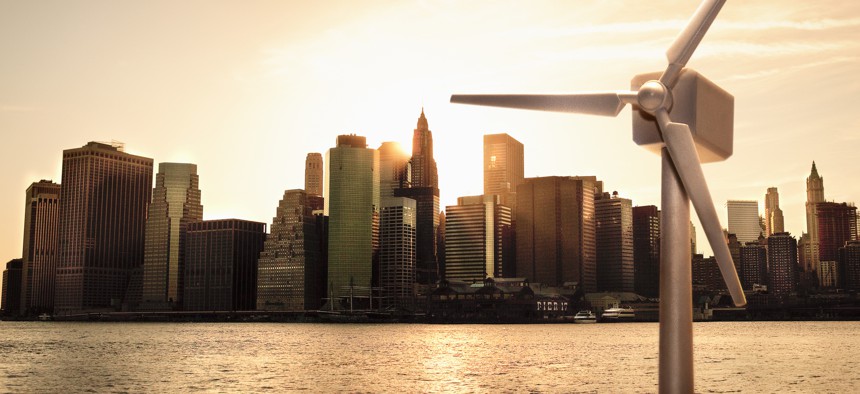Energy & Environment
Opinion: Employ vulnerable communities to build New York’s clean energy transition
In order to right deep-rooted environmental inequities, the state’s clean energy transition should provide communities of color with access to quality job opportunities in the new green economy.

Vulnerable communities should have access to quality job opportunities in New York’s new green economy in order to right long-standing environmental inequities, writes Davon Lomax of District Council 9 of the International Union of Painters and Allied Trades in New York. Steve Prezant, The Image Bank
In New York and nationwide, working-class communities of color have often borne the brunt of pollution, environmental hazards and climate change. New York has taken meaningful steps to correct these injustices by directing environmental cleanup and resiliency efforts toward vulnerable communities. However, there is more that needs to be done. To right long-standing environmental inequities, we must also consider the economic impacts and opportunities that a just transition to a sustainable future will bring.
Transitioning to a cleaner, greener economy will mean overhauling our energy system and shoring up infrastructure. This will bring a myriad of new jobs, but will unfortunately come with the loss of other ones. To ensure that New York’s transition to a climate-ready future is equitable, communities of color who have been most hurt by climate change must have access to quality job opportunities in the new green economy. Employing union labor in the clean energy space can ensure these jobs are well-paid, family-sustaining and accessible to diverse communities.
Unions actively invest in diversifying their membership and recruiting within disadvantaged communities. For example, a higher share of Black workers in the U.S. belong to unions, compared to their white counterparts.
In contrast, less than 40% of workers in the U.S. clean energy economy are people of color. Black and Hispanic workers are underrepresented in the industry, compared to their share of the overall job market. We must increase this representation to ensure the communities who have long been impacted most heavily by climate change receive the economic opportunities that addressing this crisis presents.
A recent survey of U.S. solar workers found that one of the top recruitment methods for filling open positions in the industry relied on professional and personal networks. This reliance on networks tends to overlook candidates from diverse backgrounds. If clean energy projects instead contracted with unions, they would in turn utilize unions’ inclusive recruiting methods, such as attending job fairs in front-line communities, presenting on apprenticeship programs at local high schools and recruiting from skills training programs in disadvantaged communities.
Utilizing unions in the clean energy sector will also ensure that the work is carried out at the highest quality and that workers receive good wages, safety protections, benefits and fair treatment. Unions negotiate contracts that ensure jobs provide stable pathways to the middle class for their members.
Here in New York, we have already laid the groundwork to connect high-quality union jobs to the growing green economy. The Cornell University Climate Jobs Institute delivers training for union members on climate change and clean energy, and connects policymakers with labor, environmental and industry leaders to navigate this historic transition. The Climate Jobs New York coalition brings together unions to advocate for a clean energy economy at the scale climate science demands, with good union jobs to build it.
With over 1.7 million union members in New York state – about 20% of the state’s workforce – New York is one of the strongest union states in the country. We are poised to be a national example of how to bring clean energy jobs online in the communities most in need of environmental justice.
I know how life-changing a union career can be for people of color and folks from working-class backgrounds, because it changed my life. During high school, I realized that college was not for me, but I still wanted to create a good life for myself and my family. I joined a New York City Construction Skills program designed to provide high school students entry-level training for the construction industry. After school, I joined the District Council 9 International Union of Painters and Allied Trades apprentice program. I went on to become a union member, shop steward, foreman, and now, the political director of my union. I have a comfortable life, with competitive benefits and retirement savings.
More New Yorkers can pursue this same kind of pathway to a stable, middle-class life through the employment opportunities provided by the rapidly growing clean energy economy – but these jobs must be accessible and well-paid. Unions can ensure that. State officials have a responsibility to make sure green infrastructure and clean energy projects are built with labor rights in mind. Working-class New Yorkers who have shouldered the biggest burdens of our environmental degradation can be the ones to bring us out of the climate crisis, but we must make this work available to them. This is what a just transition to a clean energy economy – and truly reckoning with the realities of environmental justice – requires of us.
Davon Lomax is the Political Director at District Council 9 of the International Union of Painters and Allied Trades (IUPAT) in New York.

NEXT STORY: Opinion: For a healthier city, New York must pass the Community Land Act

